These NCERT Solutions for Class 6 Science Chapter 2 Components of Food Questions and Answers are prepared by our highly skilled subject experts to help students while preparing for their exams.
Components of Food NCERT Solutions for Class 6 Science Chapter 2
Class 6 Science Chapter 2 Components of Food Textbook Exercise Questions and Answers
Question 1.
Name the major nutrients in our food.
Answer:
The major nutrients in our food are carbohydrates, proteins, fats, vitamins, minerals, dietary fibres and water.
Question 2.
Name the following:
a. The nutrients which mainly give energy to our body.
b. The nutrients that are needed for the growth and maintenance of our body.
c. A vitamin required for maintaining good eyesight.
d. A mineral that is required for keeping our bones healthy.
Answer:
a. Carbohydrates and fats
b. Proteins
c. Vitamin A
d. Calcium
Question 3.
Name two foods each rich in:
a. Fats
b. Starch
c. Dietary fibre
d. Proteins
Answer:
a. Fats: Butter and ghee
b. Starch: Raw potato and rice
c. Dietary fibre: Spinach and cabbage
d. Proteins: Milk, eggs, fish and meat
![]()
Question 4.
Tick (✓) the statements that are correct.
a. By eating rice alone, we can fulfil nutritional requirement of our body.
b. Deficiency diseases can be prevented by eating a balanced diet.
c. Balanced diet for the body should contain a variety of food items.
d. Meat alone is sufficient to provide all nutrients to the body.
Answer:
a. Incorrect
b. Correct
c. Correct
d. Incorrect
Question 5.
a. ………………. is caused by deficiency of Vitamin D.
b. Deficiency of ………………. causes a disease known as beri-beri.
c. Deficiency of Vitamin C causes a disease known as ……………….
d. Night blindness is caused due to deficiency of ………………. in our food.
Answer:
a. Rickets
b. Vitamin B1
c. Scurvy
d. Vitamin A
NCERT Extended Learning Activities and Projects
Question 1.
Prepare a diet chart to provide balance diet to a twelve year old child. The diet chart should include food items which are not expensive and are commonly available in your area.
Answer:
Do it yourself.
Question 2.
We have learnt that excess intake of fats is harmful for the body. What about other nutrients? Would it be harmful for the body to take too much of proteins or vitamins in the diet? Read about diet related problems to find answers to these questions and have a class discussion on this topic.
Answer:
Excessive intake of any nutrient may prove harmful and can lead to several health related problems.
![]()
Question 3.
Test the food usually eaten by cattle or a pet to find out which nutrients are present in animal food. Compare results obtained from the whole class to conclude about balanced diet requirements for different animals.
Answer:
Animals eat a variety of food and fodder. It comprises of various nutrients including proteins, carbohydrates, fibres, vitamins, minerals, etc. They also eat a large amount of cellulose from the leaves and grasses.
Activity 1
Objective: To test the presence of starch in potato.
Materials Required: A potato, knife, iodine solution and dropper.
Procedure:
- Take a piece of freshly cut potato.
- Put 2-3 drops of dilute iodine solution on the freshly cut surface of the potato piece with the help of a dropper.
- If the colour of the cut surface of potato becomes blue-black, then it indicates the presence of starch in it.
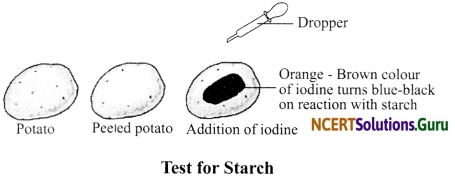
Observation: The potato turns iodine solution to blue-black colour.
Conclusion: The appearance of blue-black colour shows that potato contains starch.
ii. Fats: The energy-providing substances in the food are called fats. They are the richest source of energy. Fats produce more energy than carbohydrates, e.g., ghee, oiL, butter, etc. Food containing fats and carbohydrates are called energy giving foods.
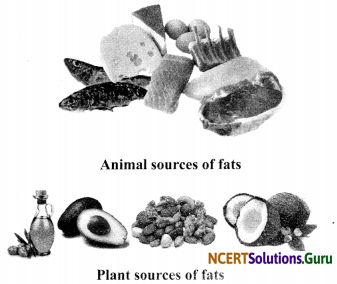
Activity 2
Objective: To test the presence of fats in the given food sample.
Materials Required: Foods sample (groundnut) and paper.
Procedure:
- Take some solid food item and wrap it in a piece of paper.
- Crash the food in the paper without tearing it.
- Open and observe the paper carefully.
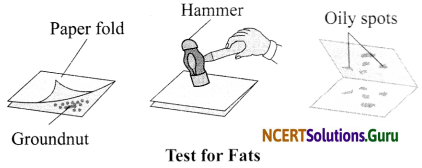
Observation: An oily patch appears on the paper.
Conclusion: The oily patch on paper indicates the presence of fats.
iii. Proteins: Proteins are called the body building food. They are essential for the growth and repair of the body tissues. Milk, pea. pulses. nuts, eggs and meat are sources of proteins.
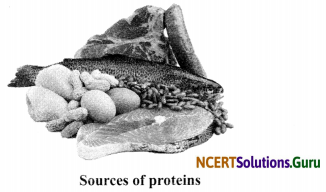
![]()
Activity 3
Objective: To test the presence of protein in a solid foodstuff.
Materials Required: Crushed foodstuff, copper sulphate solution, sodium hydroxide solution, water, test tube and Bunsen burner.
Procedure:
- Take some crushed foodstuff such as sprouted seeds, in a test tube.
- Put in some water to the test tube and shake it, keeping its mouth covered with your thumb.
- Fleat the test tube for sometime over burner.
- After it has cooled down, add a two drops of copper sulphate solution and ten drops of sodium hydroxide solution to the test tube.
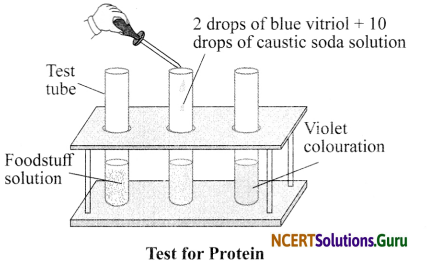
Observation: A violet colour develops in the solution.
Conclusion: The violet colour indicates that the given foodstuff contains proteins.
iv. Vitamins: The substances which are required in very small quantities by our body to keep eyes. bones, teeth and gums healthy are called vitamins. They do not provide energy. They are called protective food.
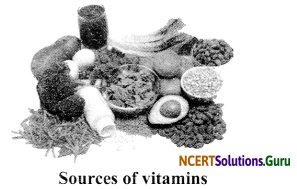
| Vitamin | Food Source | Function |
| Vitamin A | Carrot, papaya, mango | Keeps skin and eyes healthy |
| Vitamin B | Wheat, rice, liver | Enhances energy and brain functioning |
| Vitamin C | Orange, tomato, lemon, amla, guava | Helps body to fight against diseases |
| Vitamin D | Fish, egg, liver | Helps body to use calcium for our bones and teeth |
v. Minerals: The substances which are required by our body in very small quantities and protect our body are called minerals. They do not provide energy. They are also protective food.
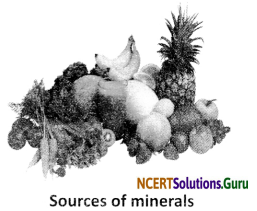
| Mineral | Sources |
| 1. Iodine | Spinach, ginger, fish |
| 2. Phosphorus | Milk, banana, grains |
| 3. Iron | Apple, spinach, liver |
| 4. Calcium | Milk, eggs |
- Cellulose is a tasteless white powdery material. It is present in plant cell-wall, wood, cotton, etc. Human beings cannot digest cellulose.
- Roughage: It consists of the tough parts of vegetables and grains that help you to digest your food and help your bowels to work properly. These are also called dietary fibres and are mainly present in plant products such as whole grains, pulses, fresh fruits and vegetables.
- Our body also needs water to absorb nutrients from food and removing waste in the form of urine, sweat, etc. We can get water through liquids such as drinking water, tea, milk and eating cooked food.
- Balanced diet: A diet which contains adequate amounts of all essential nutrients, namely, carbohydrates, fats, proteins, vitamins, minerals and roughage, in the right proportions is called a balanced diet. Examples of foods that contain a lot of nutrients include pulses, soybean, groundnut, sprouted seeds, fermented foods, jaggery, sattu, etc.
- Cooking of Food: Vegetables and fruits should be washed before peeling them to avoid washing away of nutrients. The skins of some fruits and vegetables is also rich in vitamins and minerals and hence should be consumed. Cooking may result in loss of certain nutrients. For example, vitamin C is destroyed on heating. Hence we should prepare and cook food carefully.
- Obesity: It is a condition which arises by eating fat rich food in excess. It may further cause many problems like increase in body weight, heart diseases, hypertension, etc.
- Deficiency Diseases; The diseases which arise due to the lack of nutrients like carbohydrates, fats, proteins, minerals or vitamins in our diet are called deficiency diseases, e.g., goitre, anaemia, beri-beri, scurvy, etc.
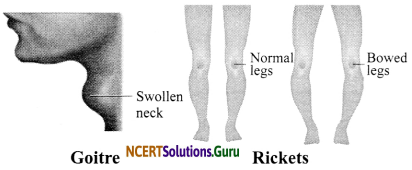
| Vitamin/Mineral | Deficiency disease/disorder | Symptoms |
| Vitamin A | Loss of vision | Poor vision, loss of vision in darkness (night), sometimes complete loss of vision |
| Vitamin B1 | Beri-beri | Weak muscles and very little energy to work |
| Vitamin C | Scurvy | Bleeding gums, wounds take longer time to heal |
| Vitamin D | Rickets | Bones become soft and bent |
| Calcium | Bone and tooth decay | Weak bones, tooth decay |
| Iodine | Goitre | Glands in the neck appear swollen, mental disability in children |
| Iron | Anaemia | Weakness |
Class 6 Science Chapter 2 Components of Food Additional Important Questions and Answers
Very Short Answer Type Questions
Question 1.
Do all foods contain all the required nutrients?
Answer:
No, all foods do not contain all the nutrients required by our body.
Question 2.
Name any two substances which provide carbohydrates.
Answer:
Potato, rice, wheat, sugar, etc.
Question 3.
What are the two nutrients which protect the body from diseases?
Answer:
Vitamins and minerals.
![]()
Question 4.
What type of food is called the body-building food?
Answer:
The food containing proteins is called body-building food.
Question 5.
Name a vitamin which represents a group of vitamins.
Answer:
Vitamin B-complex.
Question 6.
Define roughage.
Answer:
The food containing plant fibres which are also known as dietary fibres is called roughage.
Question 7.
What is the main function of roughage?
Answer:
The main function of roughage is to help our body get rid of undigested food.
Question 8.
Name the food items which provide roughage.
Answer:
Whole grains, fresh fruits and vegetables are the main sources of roughage.
Question 9.
A person decides to take only milk and nothing else in his diet for certain reasons. After a year his gums started bleeding. What could be the cause of gum bleeding?
Answer:
Deficiency of vitamin C is the main cause of gum bleeding which leads to the disease called scurvy. This is because milk does not contain vitamin C.
![]()
Question 10.
Which disease is caused due to the deficiency of calcium, phosphorus and vitamin D?
Answer:
Rickets in children and osteomalacia in adults.
Question 11.
What is obesity?
Answer:
Obesity is a disease in which a person becomes over-weight and bulky due to excessive accumulation of fats in the body.
Question 12.
Which vitamin is present in large amounts in citrus fruits?
Answer:
Vitamin C.
Short Answer Type Questions
Question 1.
What are the nutrients? Name the major nutrients.
Answer:
The components of food which are needed by our body for growth and development are called nutrients. Carbohydrates, fats, proteins, vitamins and minerals are the major nutrients.
Question 2.
Explain the importance of proteins in the human body.
Answer:
Proteins are one of the most important nutrients. They are called body-building food. They help in the growth and repair of damaged cells and tissues of the body. They also help our body to fight against infections. They make our nails, hair and muscles.
![]()
Question 3.
State two conditions which necessitate a high protein diet.
Answer:
- A growing child needs a high-protein diet to make the body tissues required for rapid growth.
- A caring mother who breast-feeds her baby needs a protein rich diet for the formation of milk in her body.
Question 4.
What are the causes of the disease ‘Kwashiorkor’? How can it be prevented?
Answer:
The disease Kwashiorkor occurs due to the deficiency of proteins in the diet of children. This happens when the child is weaned too soon from proteins-rich breast milk of the mother and given protein-deficient diet. This disease can be prevented by giving the child a sufficient amount of protein-rich diet consisting of wheat, gram, peanuts, soybean and jaggery.
Question 5.
Define fats. Name some fat containing substances.
Answer:
The energy rich sources of food are called fats. Fats provide energy to the body. All types of nuts, mustard seeds, milk and butter are the major sources of fat.
Question 6.
How can we test for the presence of fat in a food item?
Answer:
Take small quantity of the food item. Mash it on a piece of white paper. Observe carefully and you will find that the piece of white paper shows an oily patch on it which indicates that the food item contains fat.
![]()
Question 7.
Define vitamins. Name the various types of vitamins.
Answer:
Vitamins are protective compounds with no energy value. They help in proper body functioning and are required by the body in very small quantities. Various kinds of vitamins are-Vitamin A, Vitamin B-complex, Vitamin C, Vitamin D, Vitamin E and Vitamin K.
Question 8.
Explain the functions of water in our body.
Answer:
Water helps our body to absorb nutrients from the food. It also helps in removing the waste materials from the body in the form of urine and sweat.
Question 9.
What are the functions of minerals?
Answer:
Minerals are the protective part of our foods occurring naturally. They are needed by our body in small amounts. They are essential for proper growth of the body and to maintain good health. They do not provide energy. The main sources of minerals are milk, salt, eggs and green leafy vegetables.
Long Answer Type Questions
Question 1.
Explain deficiency diseases. Name the diseases caused by the deficiency of vitamins and minerals respectively.
Answer:
The diseases which occur due to the lack of adequate and balanced diet are called deficiency diseases. The deficiency diseases arise due to the lack of nutrients like carbohydrates, fats, proteins, minerals or vitamins in the diet of a person.
- Diseases caused by the deficiency of vitamins are: Night-blindness, beri-beri, scurvy, rickets and anaemia.
- Diseases caused by the deficiency of minerals are: Anaemia, cretinism, goitre, rickets and osteomalacia.
![]()
Question 2.
Describe the sources of various vitamins and their deficiency diseases.
Answer:
- Vitamin A: It is a fat-soluble vitamin. Its good sources are fish oil, milk, milk products and carrots. Its deficiency causes night-blindness.
- Vitamin B: It is water soluble. It is found in wheat, rice, yeast extract, liver and kidney. Lack of vitamin B causes beri-beri.
- Vitamin C: It is water soluble. It is found in citrus fruits and in many fresh vegetables. Lack of vitamin C causes scurvy.
- Vitamin D: It is fat soluble. It is found in fish, eggs, milk and milk products. Its deficiency causes rickets.
Question 3.
List various types of nutrients and write the functions of each.
Answer:
The various types of nutrients are:
- Carbohydrates: They are mainly energy-providing nutrients.
- Fats: They provide energy for the body. They give much more energy than carbohydrates if consumed in same amount.
- Proteins: They are called body-building foods. They help in the formation and repairing of the body parts. Skin, hair, muscles, enzymes, etc., are all made up of proteins.
- Vitamins: They help in protecting our body against diseases. They also protect eyes, bones, teeth and gums.
- Minerals: They are essential for proper growth of body and to maintain good health.
Question 4.
How would the balanced diet of a rickshaw puller differ from that of an office worker?
Answer:
The balanced diet of a rickshaw puller should include more of carbohydrates and fats than that of office workers. A rickshaw puller needs more energy for doing the hard physical work of pulling the rickshaw which can be provided by including more carbohydrate and fats in his diet. An office worker has no such requirement.
Question 5.
Four unlabelled test tubes containing sugar, starch, fat and proteins got mixed up. What tests will you perform to identify the nutrient in each test tube?
Answer:
- The test tube whose contents give a blue-black colour on adding dilute iodine solution will contain starch.
- The test tube whose contents give a red precipitate on heating with Benedict’s solution will contain sugar.
- The test tube whose contents give a greasy spot when rubbed on a white sheet of paper contains fat.
- The test tube whose contents give a violet colour on adding two drops of copper sulphate and ten drops of caustic soda will contain proteins.
Picture-Based Questions
Question 1.
Observe the following figures and answer the following questions:
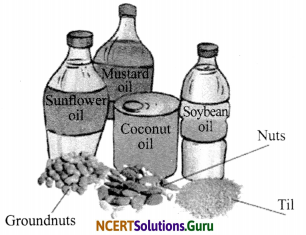
a. Which nutrients is mainly provided by these items?
b. Name the sources of these food items.
Answer:
a. They provide mainly fats.
b. The source of these food items is animals.
Question 2.
Observe the following diagrams and answer the following questions:
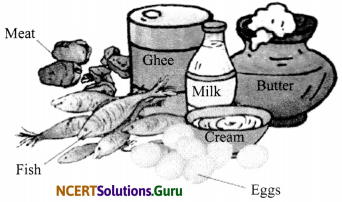
a. Which nutrient is mainly provided by these items?
b. Name the sources of these food items.
Answer:
a. They provide mainly fats.
b. The source of these food items is animals.
![]()
Question 3.
a. Identify the food items A and B.
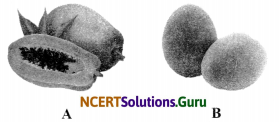
b. Which of the above contains vitamin A?
c. Deficiency of which of the above causes disease called rickets?
Answer:
a. A-Papaya
B-Eggs
b. Papaya
c. Eggs